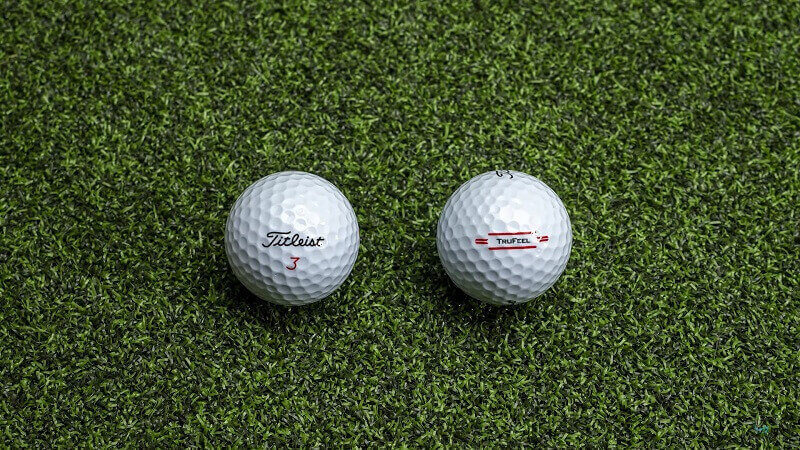With a seemingly endless array of golf ball brands and models, it’s no surprise that questions arise regarding the size of golf balls. Are all golf balls the same size? Have they been like this forever or has there been some variation over time? By the conclusion of this article, you’ll be equipped with expansive knowledge about everything related to golf ball dimensions!
Are All Golf Balls The Same Size?
Believe it or not, not all golf balls are created equal in size. While there is a standard size for golf balls used in competitions, slight variations can be found in the market.
According to the rules established by the United States Golf Association (USGA) and the Royal and Ancient Golf Club of St Andrews (R&A), golf balls used in tournament play must have a minimum diameter of 1.68 inches (4.27 cm) and a maximum weight of 1.62 ounces (45.93 grams).
The ball must also be spherical in shape and have a symmetrical arrangement of dimples. However, there may be slight variations in size and weight among different brands and models of golf balls.
What Is The Standard Size Of A Golf Ball?
To gain the USGA’s recognition and approval, a golf ball must fulfill specific criteria:
- Diameter: A golf ball must have a minimum diameter of 1.68 inches (42.67 millimeters).
- Weight: The weight of a golf ball must not exceed 1.62 ounces (45.93 grams).
- Circumference: The circumference of a standard golf ball is approximately 5.28 inches or 13.4 centimeters. This measurement is taken around the widest part of the ball, which is known as its equator.
- Dimples: Manufacturers have the freedom to implement technology and create any number of dimples on a golf ball. Due to size constraints, most are limited to around 500 or fewer. For instance, the popular Titleist Pro V1 has 392 dimples adorning its exterior.
Do you want to know why the ball has dimples? And how does it affect the flight of the ball? You can dig deeper into dimples on a golf ball here: How Many Dimples Are On A Golf Ball?
What Is The Size Of Golf Balls In Cm?
The diameter of a golf ball is approximately 4.27 cm, and in millimeters, it is approximately 42.67 mm.
The circumference of a golf ball can be calculated using the formula C = πd (where C is circumference and d is diameter), which gives a circumference of approximately 13.42 cm or 134.18 mm.
The weight of a golf ball is 45.93g or 1.62 ounces.
Do you know what golf ball Tiger Woods uses? Learn more about the ball and the type of club he uses: What Golf Clubs Tiger Woods Use?
Differences Between Two-Piece, Three-Piece And Multi-Layer Golf Balls
Golf balls come in various sizes and types to accommodate different skill levels, playing conditions, and personal preferences. The most common golf ball types include two-piece, three-piece, and multi-layer golf balls. Each type of ball has its own unique design and construction, which can affect its performance and feel. Here are some of the key differences between these three types of golf balls:
Two-Piece Golf Ball
Two-piece golf balls are the most common type of golf ball and are often used by beginners and high-handicap golfers. These balls are made up of a large solid core and a tough outer layer, usually made of Surlyn or other hard plastic materials. The hard outer layer provides durability and helps reduce spin, while the large core provides maximum distance. Two-piece golf balls are generally less expensive than other types of balls and are a good choice for golfers who want to save money and achieve maximum distance.
The size is 42.67 mm in weight and 1.68 inches in diameter.
Three-Piece Golf Ball
Three-piece golf balls are designed for intermediate to advanced golfers who want more control and spin around the greens. These balls have a softer outer layer made of materials like urethane or balata, which allows for more spin and control on short shots. The middle layer is usually made of rubber or similar material, while the core is smaller than in a two-piece ball, allowing for more feel and control. Three-piece balls are more expensive than two-piece balls but offer better performance for skilled golfers.
Three-piece golf balls are the same size as two-piece balls – they measure 1.680 inches in diameter and weigh 45.93 grams each.
Multi-Layer Golf Ball
Multi-layer golf balls, also known as “tour” balls, are the most advanced type of golf ball available. They have several layers of different materials, including a soft outer layer made of urethane or other high-performance materials, a middle layer made of rubber or other materials, and a small core. These balls provide the best combination of distance, control, and spin and are designed for professional and low-handicap golfers. They are also the most expensive type of golf ball.
It is the same size and weight as 2 and 3-piece balls. The diameter is 1.68 inches or 42.67 mm, and it weighs 45.93 grams or 1.62 ounces.
In addition to learning more about golf balls, It might also be a good choice to have some custom pins for golfers who are obsessed with this sport. These pins can be featured some golf elements like balls, as decoration on your bag.

Read more:
- The 10 Best Drivers for High Handicappers 2023
- Golf Bag Size: Height, Weight and Diameter
- Golf Hole Size: Diameter & Depth (In inches, cm & mm)
References: https://en.wikipedia.org/wiki/Golf_ball


